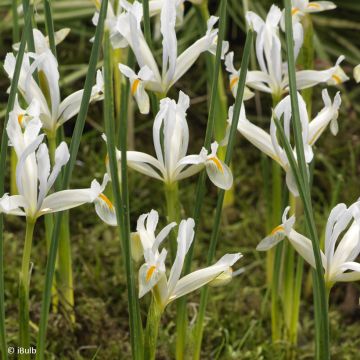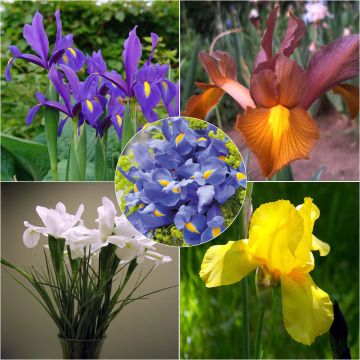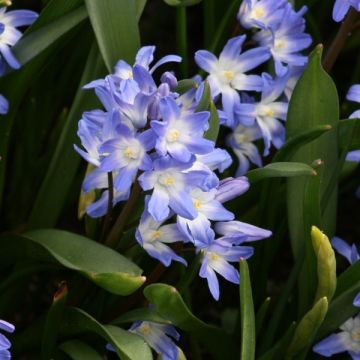

Gynandris sisyrinchium - Iris sisyrinchium


Gynandris sisyrinchium - Iris sisyrinchium


Gynandris sisyrinchium - Iris sisyrinchium


Gynandris sisyrinchium - Iris sisyrinchium


Gynandris sisyrinchium - Iris sisyrinchium


Gynandris sisyrinchium - Iris sisyrinchium


Gynandris sisyrinchium - Iris sisyrinchium


Gynandris sisyrinchium - Iris sisyrinchium
Gynandris sisyrinchium
Gynandris sisyrinchium
Barbary Nut, Gynandriris sisyrinchium
Bulbs ordered in the autumn, and all grown well! Excellent!
vincent, 01/02/2024
Special offer!
Receive a €20 voucher for any order over €90 (excluding delivery costs, credit notes, and plastic-free options)!
1- Add your favorite plants to your cart.
2- Once you have reached €90, confirm your order (you can even choose the delivery date!).
3- As soon as your order is shipped, you will receive an email containing your voucher code, valid for 3 months (90 days).
Your voucher is unique and can only be used once, for any order with a minimum value of €20, excluding delivery costs.
Can be combined with other current offers, non-divisible and non-refundable.
Why not try an alternative variety in stock?
View all →This plant carries a 6 months recovery warranty
More information
We guarantee the quality of our plants for a full growing cycle, and will replace at our expense any plant that fails to recover under normal climatic and planting conditions.
Would this plant suit my garden?
Set up your Plantfit profile →
Description
The Iris or Gynandris sisyrinchium (synonym Moraea sisyrinchium) is a small bulbous plant closely related to irises that flowers in spring in the clayey plains of the Mediterranean basin, which are very arid in summer. Its flowers, which vary in color but are always in shades of blue-violet, are borne in spikes above narrow foliage that disappears in summer. It is a species that is very well adapted to its habitat: it will be quite easy to acclimatize in a garden in the Midi region that is not too cold in winter, in clay-limestone soil and in full sun. Cultivating it in pots in other climates remains delicate.
The Iris sisyrinchium, sometimes called False Sisyrinchium, is found from Spain, Portugal, and Morocco to the far west of Europe, passing through Algeria, Sicily, Corsica, southern Italy, Greece, Egypt, Palestine, Asia Minor, Persia, and Baluchistan to Afghanistan and Punjab in the east. This species is protected in France, where it is only found in Corsican dry meadows on very alkaline soil, after disappearing from Var.
Its bulb, small and globose, is covered with shaggy fibers. In late winter, very narrow, incurved leaves appear. Flowering occurs from February to April depending on the climate, usually in April in Corsica and southern France. A floral stem rises to 30-40 cm (12-16in) from the ground. At its top, and sometimes on the sides, it bears a bouquet of small flowers with a bright blue-violet color, but variously marked with orange and white at the base of the petals, often fragrant. Each flower is ephemeral and only lives for a few hours: it opens in late morning and wilts in the afternoon. However, many flowers open successively. The foliage dries up after flowering, while the plant goes into dormancy. During this time of year, the bulb should 'cook' in very dry clay.
If your climate and soil allow it, this Gynandris will create beautiful spring scenes with fragrant Oriental hyacinths, dwarf irises, or Peruvian squills that appreciate the same growing conditions. Also, plant the bulbs in small groups among low shrubs such as thyme, lavender, or oregano. Left in place, they will multiply year after year to form flowering clumps in spring.
Report an error about the product description
Gynandris sisyrinchium in pictures




Plant habit
Flowering
Foliage
Botanical data
Gynandris
sisyrinchium
Iridaceae
Barbary Nut, Gynandriris sisyrinchium
Mediterranean
Planting and care
Plant the bulbs in September-October, in a sunny location, in clay, alkaline or limestone soil. Plant the bulbs 8 cm (3in) deep, spaced 30 cm (12in) apart. Water well to promote establishment. Once established, the sisyrinchium iris will thrive without any watering, in fact, watering should be avoided in summer: its bulb likes to 'cook' in the clay during summer. Leave the bulbs in place for several years. Outside Mediterranean climates, this bulbous plant can be grown in a pot, which allows it to be protected from cold in winter and from water in summer.
Divide the clumps after 4 to 5 years, when they seem less floriferous. Do this once the leaves have dried, at the beginning of the resting period.
The leaves of the sisyrinchium iris should only be cut when dry: they allow the bulb to replenish its reserves for the following spring flowering. Remove the pods when they form, so that the plant does not exhaust itself producing seeds.
Planting period
Intended location
Care
-
, onOrder confirmed
Reply from on Promesse de fleurs
Similar products
Haven't found what you were looking for?
Hardiness is the lowest winter temperature a plant can endure without suffering serious damage or even dying. However, hardiness is affected by location (a sheltered area, such as a patio), protection (winter cover) and soil type (hardiness is improved by well-drained soil).

Photo Sharing Terms & Conditions
In order to encourage gardeners to interact and share their experiences, Promesse de fleurs offers various media enabling content to be uploaded onto its Site - in particular via the ‘Photo sharing’ module.
The User agrees to refrain from:
- Posting any content that is illegal, prejudicial, insulting, racist, inciteful to hatred, revisionist, contrary to public decency, that infringes on privacy or on the privacy rights of third parties, in particular the publicity rights of persons and goods, intellectual property rights, or the right to privacy.
- Submitting content on behalf of a third party;
- Impersonate the identity of a third party and/or publish any personal information about a third party;
In general, the User undertakes to refrain from any unethical behaviour.
All Content (in particular text, comments, files, images, photos, videos, creative works, etc.), which may be subject to property or intellectual property rights, image or other private rights, shall remain the property of the User, subject to the limited rights granted by the terms of the licence granted by Promesse de fleurs as stated below. Users are at liberty to publish or not to publish such Content on the Site, notably via the ‘Photo Sharing’ facility, and accept that this Content shall be made public and freely accessible, notably on the Internet.
Users further acknowledge, undertake to have ,and guarantee that they hold all necessary rights and permissions to publish such material on the Site, in particular with regard to the legislation in force pertaining to any privacy, property, intellectual property, image, or contractual rights, or rights of any other nature. By publishing such Content on the Site, Users acknowledge accepting full liability as publishers of the Content within the meaning of the law, and grant Promesse de fleurs, free of charge, an inclusive, worldwide licence for the said Content for the entire duration of its publication, including all reproduction, representation, up/downloading, displaying, performing, transmission, and storage rights.
Users also grant permission for their name to be linked to the Content and accept that this link may not always be made available.
By engaging in posting material, Users consent to their Content becoming automatically accessible on the Internet, in particular on other sites and/or blogs and/or web pages of the Promesse de fleurs site, including in particular social pages and the Promesse de fleurs catalogue.
Users may secure the removal of entrusted content free of charge by issuing a simple request via our contact form.
The flowering period indicated on our website applies to countries and regions located in USDA zone 8 (France, the United Kingdom, Ireland, the Netherlands, etc.)
It will vary according to where you live:
- In zones 9 to 10 (Italy, Spain, Greece, etc.), flowering will occur about 2 to 4 weeks earlier.
- In zones 6 to 7 (Germany, Poland, Slovenia, and lower mountainous regions), flowering will be delayed by 2 to 3 weeks.
- In zone 5 (Central Europe, Scandinavia), blooming will be delayed by 3 to 5 weeks.
In temperate climates, pruning of spring-flowering shrubs (forsythia, spireas, etc.) should be done just after flowering.
Pruning of summer-flowering shrubs (Indian Lilac, Perovskia, etc.) can be done in winter or spring.
In cold regions as well as with frost-sensitive plants, avoid pruning too early when severe frosts may still occur.
The planting period indicated on our website applies to countries and regions located in USDA zone 8 (France, United Kingdom, Ireland, Netherlands).
It will vary according to where you live:
- In Mediterranean zones (Marseille, Madrid, Milan, etc.), autumn and winter are the best planting periods.
- In continental zones (Strasbourg, Munich, Vienna, etc.), delay planting by 2 to 3 weeks in spring and bring it forward by 2 to 4 weeks in autumn.
- In mountainous regions (the Alps, Pyrenees, Carpathians, etc.), it is best to plant in late spring (May-June) or late summer (August-September).
The harvesting period indicated on our website applies to countries and regions in USDA zone 8 (France, England, Ireland, the Netherlands).
In colder areas (Scandinavia, Poland, Austria...) fruit and vegetable harvests are likely to be delayed by 3-4 weeks.
In warmer areas (Italy, Spain, Greece, etc.), harvesting will probably take place earlier, depending on weather conditions.
The sowing periods indicated on our website apply to countries and regions within USDA Zone 8 (France, UK, Ireland, Netherlands).
In colder areas (Scandinavia, Poland, Austria...), delay any outdoor sowing by 3-4 weeks, or sow under glass.
In warmer climes (Italy, Spain, Greece, etc.), bring outdoor sowing forward by a few weeks.









































